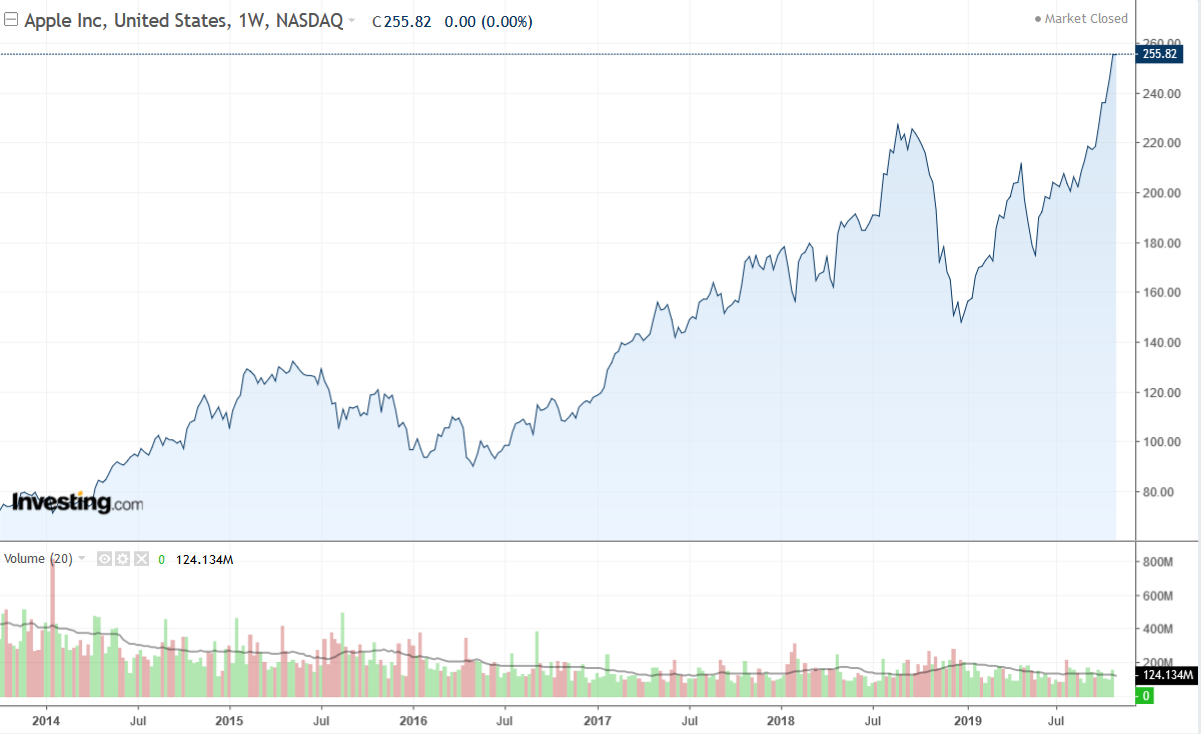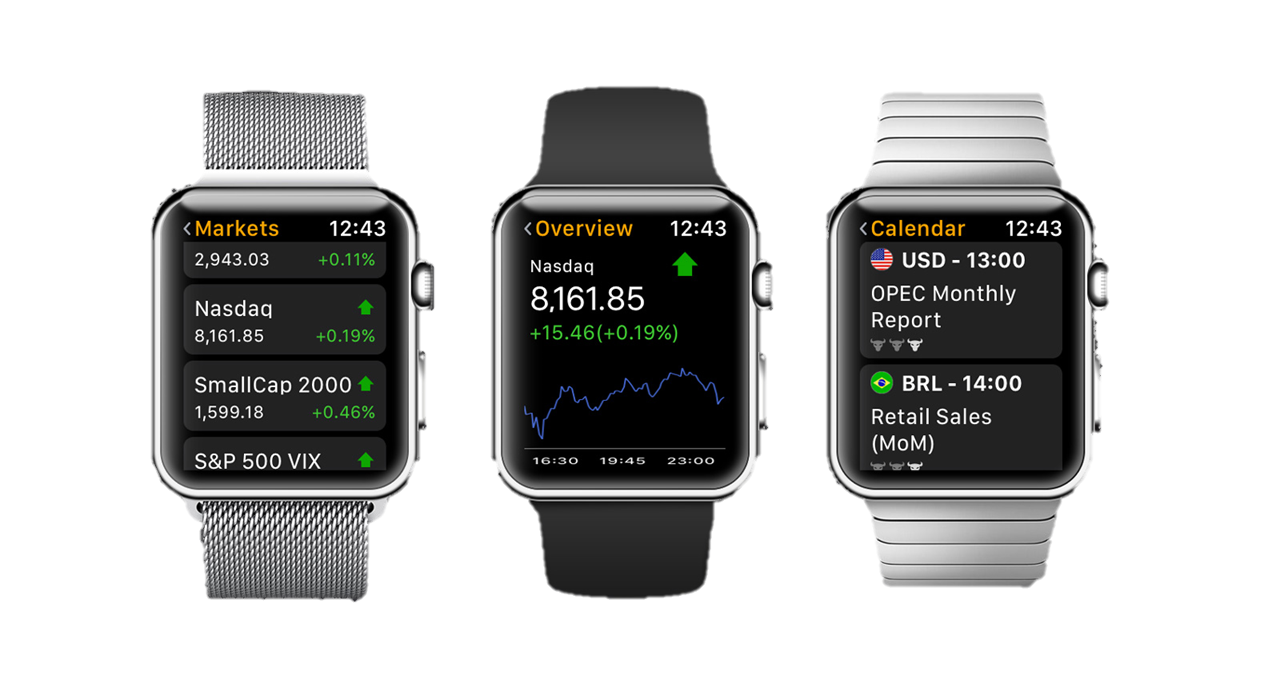The Rise Of Wearables: This Is Why Investors Should Care
Inside Investing | Dec 10, 2019 01:39PM ET
Over the past couple of decades, the prevalence of wearable devices has only grown, with Apple (NASDAQ:a new Apple Watch app and decided to do a bit of research into wearables too; can wearables become a growth engine for some of today’s largest tech stocks? Should investors bet their savings on companies that invest in wearables, or is this a fad that will soon go out of style?

Appinstitute.
But first, where did it all start?
In 1972, the Hamilton Watch Company announced the Pulsar Time Computer, which at the time was hailed as the first digital watch.
By 1975, with analogue timepieces moving to digital, screens now had the capability of displaying a range of information. These watches were considered smart for the time with computer brands like Commodore getting interested in the space.
As the digital era arrived in the 1980s, Japanese electronics maker Seiko offered a fast-growing range of smartwatch models, with the T001 providing TV-on-a-watch and the Data2000, which allowed text characters to be stored and connected to a computer. Other models added calendars, memos, simple games and snail-pace improvements in connectivity.
With nearly two decades gone by, 1999 gave us the first watch which ran on a computer operating system, paving the way for true smartwatches. Steve Mann, the father of wearables bolted Linux into a watch, while Samsung delivered the SPH-WP10 watch capable of making cell phone calls.
2004 saw Microsoft almost reinventing the category with the SPOT - which stood for Smart Personal Objects Technology - but they failed to spot the device’s true potential.
In 2009, Indies like BURG Wearables crammed a SIM card into a smartwatch, which allowed users to make phone calls and receive text messages without the need to tether to a smartphone.
Innovation in the space started to pick up rapidly at the start of the decade, when Sony introduced the Sony Smartwatch at CES 2012. Samsung then launched its own smartwatch -the Galaxy Gear Smartwatch - competing with Sony for the top spot in wearables.
In 2014, crowd-funded start-up Pebble reinvented the smartwatch, with a campaign running on Kickstarter that raised more than $10 million in funding.
Late to the game, iPhone giant Apple had plenty of work to do with its Apple Watch, unveiled in September 2015. It quickly became the best-selling wearable device with 4.2 million units sold in the second quarter of fiscal 2015.
In September 2019, Apple introduced the Apple Watch Series 5, it’s first always-on smartwatch. In a further boost to the space, Apple launched a dedicated App Store for the Apple Watch.

How Apple did its ‘thing’ for watches
Overall smartwatch sales continue to boom year-over-year, with record sales in 2018, almost doubling 2017’s sales. 2019 is shaping up to be an even stronger year; manufacturers shipped 12 million smartwatches during the second quarter of this year, a 44% increase over the same quarter last year.
In a sign of how dominant of a player Apple has become in the space, the Apple Watch accounted for nearly half of the smartwatches shipped in Q2.
The Apple Watch has made great strides since it’s first release - offering more functionality and features with each version. Pointing to the high level of satisfaction experienced with the product, 30% of Apple Watch Series 1 buyers also went on to purchase the Series 2.
Apple continued to drive interest and make the watch more attractive, with designer straps and a range of screen sizes to drive mass appeal among all users. The Cupertino-based company offers 84 possible combinations of Apple Watch and official straps.
In the future, smart-material straps are planned to become part of the interface, possessing the ability to display messages or change color to highlight exercise or stress rates.
How Apple Watch influenced Apple’s stock over the years
The global smartwatch market is experiencing impressive growth, with Apple leading the way, by a wide margin. It shipped 3.5 million smartwatch units in the second quarter of 2018, 30% more than in the same period a year earlier. Sales continue to surge with shipments of the Apple Watch up 49% in the first quarter of 2019.
Not surprisingly, the smartwatch - and its other wearable devices, which also include AirPods - has become an increasingly important business for Apple, and that has been reflected in its stock price.
Indeed, Apple shares (NASDAQ:AAPL ), which are currently trading at an all-time high, have gained roughly 104% since the first Apple Watch was released. Expectations that wearables will continue to drive growth in the years to come has Wall Street anticipating further appreciation in Apple’s stock price.
In addition, Apple has also made a big push into the health and fitness industry, providing more health data to people through its devices, including heart-rate tracking on the Apple Watch. Its foray into healthcare can become another unexpected long-term growth driver for Apple.

How has getting into the wearable space affected other tech companies?
Apple faces a constant battle to upgrade its wearable devices, as new technologies become small enough or power-efficient enough to fit into the tiny confines of Apple Watch fob.
It faces growing competition from other big-name tech players, all vying to dethrone Apple and grab its spot at the top of the wearables industry.
Alphabet-owned Google recently stated that it sees an opportunity to introduce "Made by Google" wearable devices into the market and invest more in wearable technology. Just this month, Google bought fitness tracker pioneer Fitbit for $2.1 billion. The acquisition came after a separate deal earlier this year, in which Google agreed to buy Fossil Group's intellectual property related to smartwatch technology, as it steps up its efforts to take on Apple in the burgeoning market for wearable devices.
Other key players in the space include Samsung Electronics, Sony, LG Electronics, Motorola, and Garmin. Additionally, cheaper offerings from China’s Huawei Technologies and Xiaomi have also made efforts to enhance their market penetration into the wearables market.
Should we expect high growth in the market in the near future?
As competition in the space heats up, one can clearly make the argument that the best is yet to come from the wearables industry.
According to market research firm Gartner, smartwatch sales are expected to reach 112.5 million units by 2022, which would mark an increase of a whopping 171% from sales of 41.5 million units in 2017.
The most notable tailwind the sector is set to enjoy in the coming years – and the one which is likely to provide the biggest boost to long-term growth – will be the upcoming 5G rollout, which promises superfast speeds that have the ability to support technologies like wearables. 5G will improve how much data can be fed to smartwatches, while there is plenty of room for app development to come up with new uses.
In the U.S., AT&T (NYSE:VZ ), T-Mobile and Sprint have already launched 5G networks, but only in certain cities. A gradual nation-wide rollout is expected to be completed by 2021.
How can investors use wearables to improve their investments?
In the past, smartwatches were little more than a tech accessory which allowed users to reply to messages, receive calls and even view social media notifications. These days, smartwatches are equipped with innovative features that can help simplify your life and improve your financial health.
Staying up-to-date on the latest breaking market news or keeping track of your investments has never been easier thanks to Investing.com’s groundbreaking Apple Watch app.
The app allows you to quickly and easily monitor your portfolio, view any exchange worldwide at a glance, as well as track the performance of individual stocks and breakdown their charts - all on your wrist.
More importantly, the Investing.com Apple Watch app provides real-time price alerts and news updates straight to your wrist, allowing users to always stay on top of what’s moving in financial markets.

Bottom Line
Market players searching for sweet long-term returns need to look no further than companies making strong plays in the wearables sector. Smartwatches, fitness trackers, as well as VR/AR headsets are all forecast to become more and more prevalent in our society over the next several years.
As such, investors should focus their attention on the leading names in the wearables space, which are poised to provide strong long-term growth potential.
There are more than a few attractive names in the sector which all enjoy accelerating earnings and revenue growth thanks to surging demand for their innovative products.
Overall, the wearables industry is well worth considering for any investor looking to make strong gains in the years ahead.
A flick of the wrist: Rise of the Smartwatch
We’ve partnered with Appinstitute to create this great infographic that presents the history and rise of wearables, including some interesting stats!
Share this Image On Your Site


Trading in financial instruments and/or cryptocurrencies involves high risks including the risk of losing some, or all, of your investment amount, and may not be suitable for all investors. Prices of cryptocurrencies are extremely volatile and may be affected by external factors such as financial, regulatory or political events. Trading on margin increases the financial risks.
Before deciding to trade in financial instrument or cryptocurrencies you should be fully informed of the risks and costs associated with trading the financial markets, carefully consider your investment objectives, level of experience, and risk appetite, and seek professional advice where needed.
Fusion Media would like to remind you that the data contained in this website is not necessarily real-time nor accurate. The data and prices on the website are not necessarily provided by any market or exchange, but may be provided by market makers, and so prices may not be accurate and may differ from the actual price at any given market, meaning prices are indicative and not appropriate for trading purposes. Fusion Media and any provider of the data contained in this website will not accept liability for any loss or damage as a result of your trading, or your reliance on the information contained within this website.
It is prohibited to use, store, reproduce, display, modify, transmit or distribute the data contained in this website without the explicit prior written permission of Fusion Media and/or the data provider. All intellectual property rights are reserved by the providers and/or the exchange providing the data contained in this website.
Fusion Media may be compensated by the advertisers that appear on the website, based on your interaction with the advertisements or advertisers.